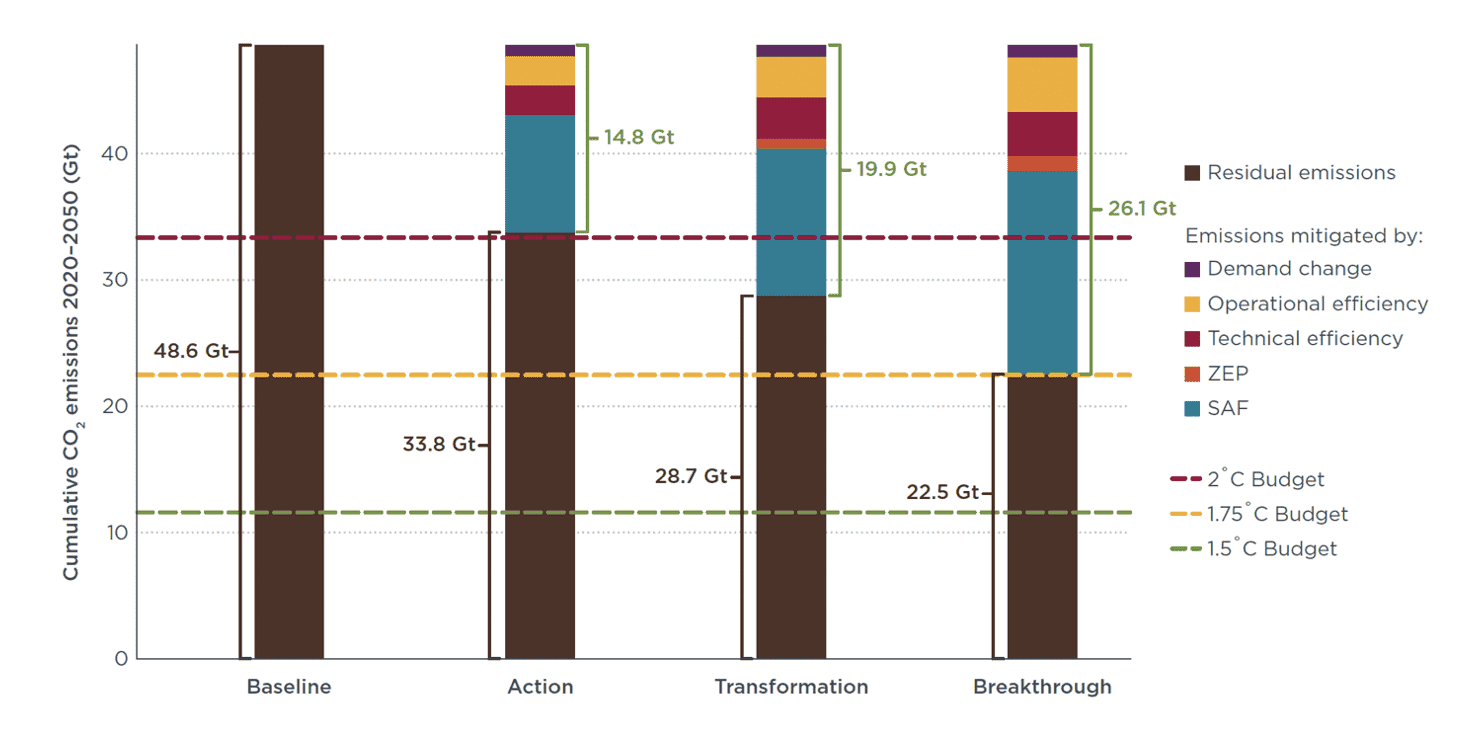Press release
Airline emissions must peak this decade if industry is to achieve Paris goals
1.75ºC target is possible but requires immediate policy action and investment
9 June 2022 (Washington, D.C.) – Today, the International Council on Clean Transportation (ICCT) released an analysis showing that global aviation could reach near-zero emissions by mid-century. The most optimistic scenario puts aviation on a path to reduce GHG emissions by an amount consistent with a 1.75ºC warming. But it would require aggressive policies to peak emissions by 2030 at the very latest.
The report develops three decarbonization scenarios—Action, Transformation, and Breakthrough—along with a Baseline scenario. Varying assumptions of traffic growth, fuel efficiency gains from new aircraft and operational improvements, the development of zero-emission planes (ZEPs), and the introduction of sustainable aviation fuels (SAFs) were modeled, as well as the economic incentives needed to pay for it all. In the Action and Transformation cases, coordinated efforts by governments and industry deliver new technologies that flatten and halve 2050 CO2 emissions compared to 2005 levels, respectively. The Breakthrough case models early, aggressive, and sustained government intervention that triggers widespread investments in zero-carbon aircraft and fuels, peaking fossil fuel use in 2025 and zeroing it out by 2050. By 2050, CO2 falls up to 94% below 2019 levels due to the use of new fuels, fuel efficiency improvements, and limited demand reduction.
“The all-in strategy to deploy clean planes and fuels cuts emissions even deeper than we expected,” said ICCT’s Brandon Graver, lead author of the study. “But public policies will be needed to peak emissions as early as 2025 to put aviation on a 1.75ºC pathway.”
In the three scenarios analyzed, SAFs account for the largest share of CO2 reduction potential, varying between 59% and 64%. That implies a large scale-up from today when SAFs account for less than 0.1% of jet fuel use. Improvements in aircraft technical and operational efficiency contribute an additional one-third of CO2 mitigation. Zero-emission planes powered by hydrogen account for 4% and 5% of emission reductions in the Transformation and Breakthrough scenarios, respectively. Modest reductions in air travel due to increases in fuel cost and modal shift to high-speed rail are also estimated.
ICCT’s report compares cumulative CO2 emissions between 2020 and 2050 to 1.5ºC, 1.75ºC, and 2ºC global carbon budgets. CO2 emissions from aircraft need to peak by 2030 at the latest, and as soon as 2025, to align aviation with the Paris Agreement. The Action scenario peaks emissions in 2030 but still uses up aviation’s entire 2ºC carbon budget by 2050, while the Breakthrough scenario achieves a 1.75ºC future after peaking emissions in 2025. In all scenarios modeled, by 2030 aviation emits as much CO2 as would be allowed under a proportional 1.5ºC pathway, the most hopeful Paris goal.

Figure 1. Cumulative global aviation CO2 emissions by scenario and measure, 2020–2050
The report applies the ICCT’s new Projection of Aviation Carbon Emissions (PACE) model to project aviation traffic, emissions, and technologies through 2050. PACE estimates the fuel and carbon prices needed to deliver low- and zero-carbon fuels. Under the Breakthrough scenario, fuel costs will increase by 34% and 70% in 2030 and 2050, respectively, due to the adoption of more expensive SAFs. Policies like a SAF mandate, low carbon fuel standard, carbon taxes, or a frequent flier levy will be needed to bridge the price gap between alternative and fossil jet fuels.
“It’s exciting to see the industry developing new technologies that can dramatically reduce aviation emissions,” said Dan Rutherford, ICCT’s aviation program director, and paper co-author. “But to fully meet the ambitions of the Paris Agreement, either atmospheric carbon removals or curbs to traffic growth will be needed.”
Since 2021, trade associations like IATA, A4A, and Sustainable Aviation have committed to net-zero emissions by 2050. At COP26, the International Aviation Climate Ambition Coalition was formed to work together to advance actions to reduce CO2 emissions from aviation to levels consistent with limiting the global average temperature increase to 1.5ºC. Twenty-eight states have signed on, including the United States, Germany, France, and the United Kingdom.
Publication details:
Vision 2050: Aligning aviation with the Paris Agreement
Authors: Brandon Graver, Ph.D., Xinyi Sola Zheng, Daniel Rutherford, Ph.D., Jayant Mukhopadhaya, Ph.D., and Erik Pronk
Contacts:
Brandon Graver, b.graver@theicct.org
Dan Rutherford, dan@theicct.org
# # #
The International Council on Clean Transportation is an independent nonprofit organization founded to provide first-rate, unbiased research and technical and scientific analysis to environmental regulators. Its mission is to improve the environmental performance and energy efficiency of road, marine, and air transportation, in order to benefit public health and mitigate climate change.
